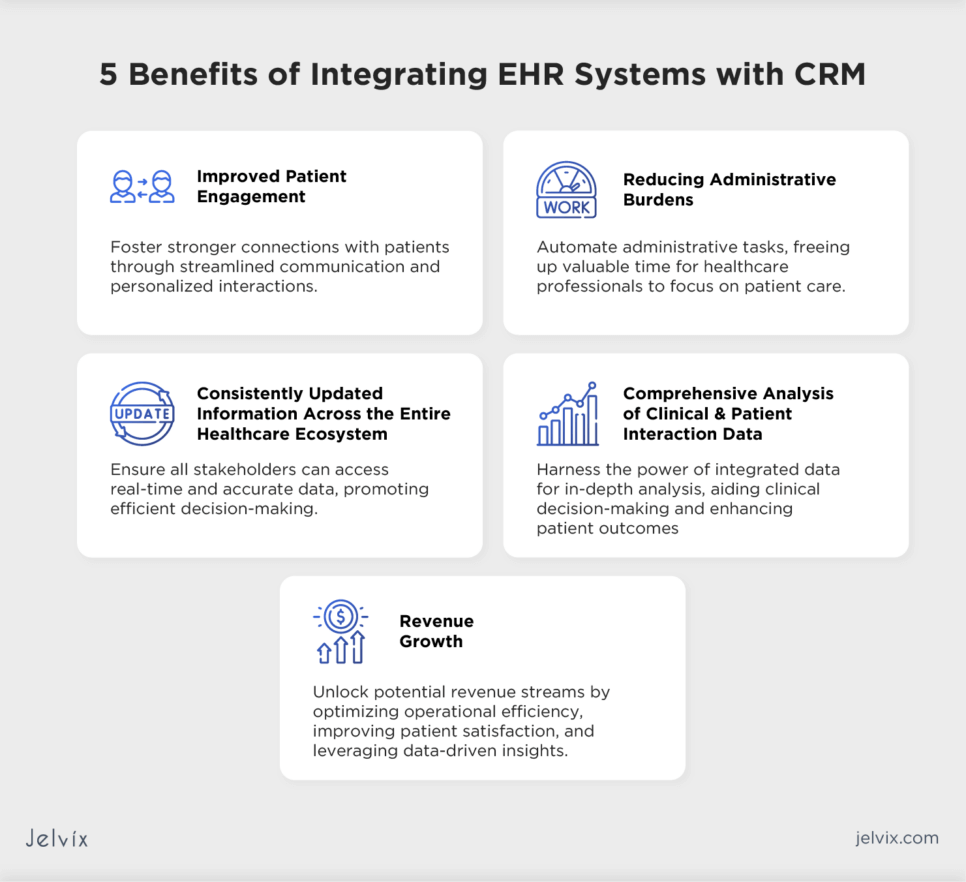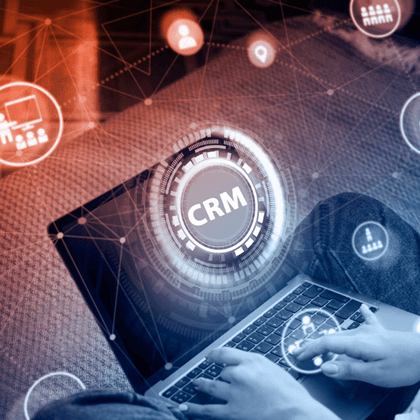With the evolving patient demand for fast and convenient medical services, healthcare providers seek ways to improve patient care. In recent years, technology helped a lot in elevating healthcare services. In the US only, 88% of office-based physicians use EMR/EHR systems to manage clinical data more efficiently.
Yet, the challenges of insufficient patient engagement and communication gaps push healthcare providers to explore innovative solutions to enhance patient experience. The integration of EHRs with CRM systems emerges as a potential problem-solver. However, navigating this integration journey can pose challenges that require expertise to be resolved.
If your goal is to improve patient experience using the power of EHR-CRM integration, keep on reading this article. You’ll discover types of integrations that may assist you best, pitfalls to avoid, and tips to perform EHR-CRM integration seamlessly.
What Do Patients Expect from Healthcare Providers in 2024?
Rapid technology development has changed healthcare delivery and impacted patient expectations for healthcare providers. Studies report that 87% of patients would like to have online access to their health information, while 43% prefer to book appointments online.
In 2024, patients expect healthcare providers to deliver a more personalized and accessible experience. They anticipate seamless digital interactions, telehealth options, and proactive health management. Transparency in treatment costs, data security, and a focus on holistic well-being are also high on their expectations.
How CRM Helps Improving Patient Engagement
Healthcare CRM systems play a vital role in improving patient engagement. They enable providers to personalize patient interactions, provide convenient communication channels, and deliver proactive healthcare services.
Nice-to-Have CRM Healthcare Integrations for Providers
For modern healthcare providers, crucial CRM software integrations include seamless connections with Electronic Health Records, marketing automation tools, billing tools, patient scheduling systems, and telehealth platforms.
There are five key CRM integrations that healthcare providers should consider:
- CRM + EHR: the integration of CRM with EHR systems ensures that patient data is accessible, up-to-date, and can be used to provide personalized experience;
- CRM + chatbots: chatbots can streamline appointment scheduling, answer frequently asked questions, and provide round-the-clock support to patients;
- CRM + survey tools: collecting patient feedback is essential for improving services. CRM systems can facilitate the collection, analysis, and utilization of patient feedback;
- CRM + billing: integrating billing systems with CRM ensures accurate and transparent financial transactions for patients;
- CRM + patient portal: a patient portal integrated with CRM allows patients to access their medical records, schedule appointments, and interact with healthcare providers seamlessly.
9 Steps to Develop a CRM in Healthcare
Developing a healthcare CRM system involves several crucial steps, from understanding the specific needs of the healthcare provider to selecting the right technology stack and ensuring seamless integration with existing systems. Following a step-by-step process will ensure the development of a robust and compliant CRM system that enhances patient management and efficiency of healthcare delivery.
Step 1. Needs Assessment
Identify and prioritize the specific requirements of your CRM. Understand the workflow, data handling needs, and desired features. Engage stakeholders, including healthcare professionals and end-users, in thorough discussions to ensure a comprehensive understanding of the organization’s unique needs and challenges.
Step 2. Regulatory Compliance Review
Ensure compliance with healthcare regulations, such as HIPAA, to safeguard patient data and maintain legal standards. Collaborate with legal and compliance experts to conduct a thorough review, addressing not only current regulations but also anticipating potential future changes to ensure ongoing compliance.
Step 3. Design and Prototyping
Create a comprehensive system design outlining the software’s architecture, features, and user interface based on the identified needs. Develop a prototype to make sure all the features work as expected. Engage end-users in the prototyping phase to gather valuable feedback for refining the design and ensuring user satisfaction.
Step 4. Development
This phase stands out as the most challenging in the healthcare CRM software development process. Here, developers embark on coding, constructing both the back-end and front-end of your CRM platform.
Step 5. Data Security Measures
Implement robust security protocols to protect sensitive patient information, including encryption and access controls. Conduct thorough risk assessments to identify potential vulnerabilities and implement measures to mitigate security risks.
Step 6. Integration with Existing Systems
Integrate your CRM software seamlessly with existing healthcare systems to ensure interoperability and data consistency. Conduct thorough compatibility testing to identify and address any integration challenges, fostering a cohesive healthcare technology ecosystem.
Step 7. Testing
Conduct rigorous testing to identify and address any bugs or issues. Ensure the software performs reliably in real-world healthcare scenarios. Implement various testing methodologies, including user acceptance testing, to guarantee the software’s functionality, reliability, and usability under diverse healthcare conditions.
Step 8. Deployment
Roll out the CRM software across the healthcare organization, ensuring a smooth transition and minimal disruption to daily operations. Develop a comprehensive deployment plan that includes training sessions for healthcare professionals and end-users to facilitate a seamless adoption process.
Step 9. Monitoring and Maintenance
Continuously monitor the CRM’s performance, addressing any issues promptly. Regularly update the software to introduce new features and ensure security. Implement proactive monitoring systems to detect and address potential issues before they impact the daily operations of your healthcare organization.
EHR vs. CRM: Key Differences
EHR and CRM serve different purposes. EHR primarily focuses on improving healthcare delivery, while CRM finds applications across diverse domains. Understanding the distinctions between the two is vital for efficient management of clinical data and patient interactions:
- Focus: EHRs are primarily designed for healthcare providers, so they concentrate on capturing and managing patient health information, such as clinical data, medical history, treatments, prescriptions, etc. CRM systems are tailored for managing relationships with patients and clients. They focus on appointment scheduling, communication history, and patient outreach.
- Purpose: EHRs aim to enhance patient care and facilitate efficient communication among healthcare professionals and support clinical decision-making. CRM systems aim to improve client satisfaction, retention, and overall experience.
- Users: EHRs are mainly used by healthcare pros such as doctors, nurses, and administrative staff within a healthcare organization. CRMs are used by healthcare administrators, marketing teams, and those responsible for patient engagement and client satisfaction.
- Features: EHR features usually include clinical documentation, order entry, decision support, e-prescribing, and other features specific to healthcare workflows. CRM incorporates patient communication tracking, appointment scheduling, marketing automation, and tools for enhancing client experience.
Wonder how you can benefit from CRM-EHR Integration with Jelvix? Discover Jelvix’s EHR development success story .
5 Benefits of Integrating EHR Systems with CRM
The global healthcare CRM market is projected to reach a revenue milestone of USD 16,500 million by the end of 2024. So, EHR-CRM integration brings forth a myriad of advantages, including increased revenue, to healthcare providers:
- Improved patient engagement: CRM-EHR integration ensures a holistic approach to patient care. The combination of clinical data and personalized engagement enhances overall healthcare outcomes;
- Data accuracy: when both systems are seamlessly connected, there is a reduced risk of data discrepancies or errors. Integrations ensure that patient information remains consistent and up-to-date across the entire healthcare ecosystem;
- Efficient operations: integrating CRM and EHR streamlines workflows for healthcare professionals, reducing administrative burdens. Automation of patient communication, appointment reminders, and follow-ups improves operational efficiency;
- Data-driven insights: the synergy between CRM and EHR allows for a comprehensive analysis of both clinical and patient interaction data. This provides valuable insights for healthcare organizations to optimize services, enhance patient engagement strategies, and make informed decisions;
- Revenue growth: the integration of CRM and EHR contributes to revenue growth by improving patient retention, attracting new patients through targeted marketing efforts, and optimizing billing processes. Efficient operations and enhanced patient satisfaction can lead to increased referrals and a positive impact on the overall financial state of healthcare organizations.
Challenges of CRM Integration with EHR
Integrating CRM systems with EHRs poses challenges due to differing data formats, security concerns, and the need for seamless interoperability. Ensuring a harmonious blend of patient engagement and clinical data requires addressing these complexities.
Data Interoperability
EHR and CRM systems often store data in different formats, use different standards, and have varying data structures. Matching and mapping the data from EHR to CRM can be challenging, leading to data incompatibility issues and potential data loss.
Think about implementing a standardized data exchange framework, such as HL7 or FHIR, to facilitate seamless mapping and data matching. Developing robust data transformation processes can be a good idea to ensure compatibility and reduce the risk of data loss.
Security and Privacy Concerns
Healthcare organizations are bound by strict regulations, such as HIPAA to protect patient data privacy and security. Integrating EHR with CRM requires stringent security measures to ensure that sensitive patient information is not compromised during the data exchange.
Maintaining data encryption, logging, and access control is crucial. Adhere strictly to healthcare regulations, conduct regular security audits, and invest in secure authentication methods to prevent possible security concerns.
Workflow Misalignment
EHRs and CRMs are used by different departments and for different purposes within a healthcare organization. Integrating these systems can lead to workflow misalignment, as employees may need to adapt to new processes and tools. This can result in resistance to change and decreased efficiency until employees become accustomed to the new workflow.
Consider conducting thorough workflow analyses before integration to identify potential misalignments. Involve key stakeholders from both departments to streamline processes, provide comprehensive training to staff, and gradually introduce changes to minimize resistance and maximize efficiency during the transition.
System Customization and Configuration
Both EHR and CRM require customization to meet the specific needs of a healthcare organization. Integrating these systems may require extensive configuration and custom development work to ensure that they work seamlessly together. This customization can be time-consuming and expensive.
Think about engaging with CRM and EHR vendors that support seamless integration and offer customization options. Prioritize interoperable solutions to minimize the need for extensive custom development. Establish a clear understanding of the organization’s specific requirements to reduce customization efforts and associated costs.
Technical Challenges
Integrating EHR with CRM may involve working with different technologies, platforms, and APIs. Technical challenges can include system downtime during the integration process, data migration issues, and software compatibility problems.
To minimize technical issues, thoroughly plan the integration process, considering potential system downtimes and data migration challenges. Conduct compatibility tests and pilot integrations. Collaborate with experienced integration specialists to ensure a smooth and technically sound integration.
Explore the benefits of real-time data entry in healthcare, from improved patient outcomes to enhanced operational efficiency.
Tips for a Successful EHR – CRM Integration
Embarking on an EHR-CRM integration journey involves careful planning, collaboration with stakeholders, vendor coordination, and commitment to data standardization. Successful healthcare software integration enhances the efficiency of healthcare operations, providing a holistic view of patient data. To ensure a smooth journey, here are 6 tips for a successful integration:
1. Thorough Planning
Begin with a comprehensive planning phase, identifying integration goals, key stakeholders, and potential challenges. A well-structured plan sets the foundation for a successful EHR-CRM integration journey. Consider developing a detailed roadmap that includes timelines, resource allocation, and contingency plans to navigate unforeseen challenges effectively.
2. Collaboration and Communication
Foster collaboration between IT teams, healthcare professionals, entrepreneurs, and CRM users. Clear communication ensures everyone is aligned on integration objectives and understands their role in the process. Establish regular communication channels, such as meetings and updates, to keep all stakeholders informed and engaged throughout the integration lifecycle.
3. Vendor Coordination
Work closely with EHR and CRM vendors. Choose systems that support interoperability and have a history of successful integrations. Establish a collaborative relationship with vendors to stay informed about updates, patches, and emerging features that can enhance the integration’s efficiency.
4. User Training and Support
Provide comprehensive training to healthcare staff and CRM users to ensure they are proficient in using the integrated systems. Ongoing support is essential to address any challenges and promote user confidence. Develop training programs that cater to different user roles, incorporating feedback from users to continuously improve training materials and support resources.
5. Incremental Implementation
Consider an incremental approach to implementation, starting with pilot programs or specific departments. This will minimize disruptions, allow adjustments, and ensure a smoother transition to the integrated EHR-CRM system. Conduct regular evaluations and gather feedback from users during incremental implementation to address any issues promptly and refine the integration process.
6. Data Security Measures
Prioritize data security by implementing end-to-end encryption, access controls, and regular security audits. Adhere to healthcare regulations, such as HIPAA, to safeguard sensitive patient information during the integration process. Collaborate with cybersecurity experts to conduct thorough risk assessments and establish robust security protocols.
Clinical Interoperability: the Role of Healthcare API
Healthcare APIs play a pivotal role in enabling clinical interoperability between EHR and CRM systems. These APIs facilitate secure and standardized data exchange, ensuring seamless communication and collaboration among disparate healthcare technologies.
How FHIR Can Improve Interoperability
Fast Healthcare Interoperability Resources (FHIR) significantly enhances interoperability by providing a modern, web-based approach to exchanging healthcare information. FHIR’s standardized data format allows for efficient data mapping and exchange between EHR and CRM, promoting interoperability and streamlined information flow across the healthcare ecosystem.
How Providers and Patients Benefit from EHR-CRM Integration
The integration of EHR and CRM systems ultimately benefits both providers and patients. Healthcare providers can offer better care, streamline operations, and reduce costs, while patients enjoy a more personalized and convenient healthcare experience.
Unified Patient Data Access
EHR-CRM integration delivers a consolidated view of patient information to healthcare providers. This unified access streamlines workflows, allowing providers to access comprehensive patient data seamlessly. For patients, this means more efficient and personalized care as healthcare teams make informed decisions based on a holistic understanding of their medical history.
Enhanced Patient Engagement
Integrating EHR with CRM enables providers to engage with patients more effectively. CRM systems facilitate personalized communication and follow-up interactions. Patients benefit from increased engagement, timely communication, and a more active role in their healthcare journey.
Improved Care Coordination
EHR-CRM integration fosters better coordination among healthcare teams. By aligning clinical and non-clinical data, providers can facilitate communication and collaboration. This results in improved care coordination, reduced errors, and a cohesive approach to patient care. Patients experience smoother transitions between healthcare services, leading to a more coordinated and holistic care experience.
Efficient Appointment Scheduling
Integration simplifies appointment scheduling. CRM systems, integrated with EHR, enable providers to minimize administrative hassles. Patients benefit from efficient scheduling processes, reduced wait times, and improved access to healthcare services.
Data-Driven Personalized Care
EHR-CRM integration enables providers to harness data for personalized care strategies. By analyzing patient data, providers can tailor treatment plans, preventive care initiatives, and health interventions. Patients receive more personalized and targeted healthcare, addressing their unique needs and promoting better health outcomes.
Bonus Tip: Choose a Dedicated Tech Partner
10 Questions to Ask Your Healthcare Tech Partner
1. What Is Your Expertise in Healthcare Technology?
Assess the depth of their experience in healthcare technology. A seasoned tech partner should understand the nuances of the industry, compliance standards, and the unique challenges faced by healthcare providers.
2. Can You Provide References from Similar Projects?
Request references to gauge their track record. Insights from previous projects in the healthcare sector demonstrate their capability, reliability, and the potential success of your collaboration.
3. How Will You Ensure Data Security and Privacy?
Data security is paramount in healthcare. Inquire about their security protocols, encryption methods, and compliance with healthcare regulations like HIPAA to safeguard sensitive patient information.
4. What Is Your Approach to Scalability and Capacity Planning?
Ensure the tech partner’s solutions can scale as your healthcare business grows. A robust infrastructure and capacity planning strategy are vital for accommodating increased data, users, and evolving business needs.
5. Would You Tell Us Aboutabout Your Innovation and Adaptability Practices?
In the fast-evolving healthcare landscape, innovation is key. A tech partner committed to staying abreast of technological advancements ensures your systems remain cutting-edge and adaptable to future industry changes.
6. How Do You Handle Support and Maintenance?
Post-implementation support is critical. Understand their support services, response times, and maintenance practices. A reliable partner should provide ongoing support to ensure the seamless operation of your healthcare systems.
7. What Long-Term Partnership Opportunities Do You Offer?
Look beyond the immediate project. A tech partner invested in a long-term relationship signifies commitment, cost-effectiveness, and alignment with your organization’s future goals.
8. What Tools and Technologies Do You Use?
Evaluate the tech stack. Familiarize yourself with the tools and technologies they employ. This insight ensures compatibility, efficiency, and the ability to integrate seamlessly with your existing systems.
9. Can You Provide a Clear Workflow Overview?
Transparency is key. A clear workflow overview during software development minimizes surprises, enhances collaboration, and ensures that your healthcare tech partner understands and aligns with your project goals.
10. How Do You Stay Informed about Industry Regulations?
Healthcare is subject to strict regulations. A tech partner staying abreast of industry standards, compliance updates, and regulatory changes demonstrates their commitment to keeping your healthcare solutions compliant and secure.
Jelvix’s Healthcare Software Development Approach
Medical software integration and development is a complicated process that requires expertise and experience. At Jelvix, we adopt a comprehensive approach to healthcare software development, combining industry expertise with cutting-edge technologies. The process begins with an in-depth analysis of healthcare challenges, client objectives, and project requirements.
We place a significant emphasis on user-centric design, creating intuitive interfaces for both healthcare professionals and end-users. We implement rigorous testing and quality assurance protocols to guarantee the reliability and effectiveness of your healthcare software.
If our vision and approach resonate with you, feel free to contact us for healthcare solution consultancy. Our managers are ready to address any questions you may have.
Jelvix’s healthcare IT consultants are here to discuss your needs and define the optimal ways for your medical organization to leverage a patient care with CRM-EHR Integration.














